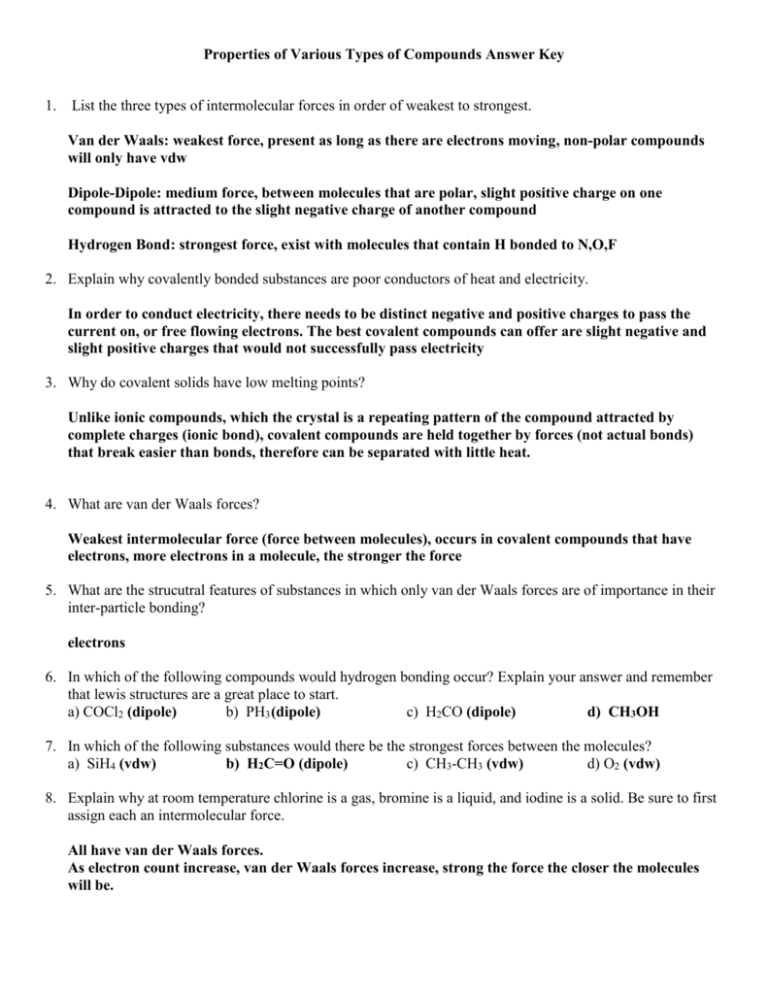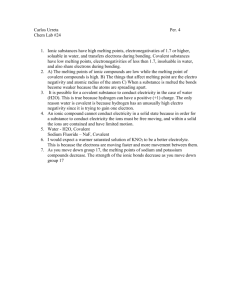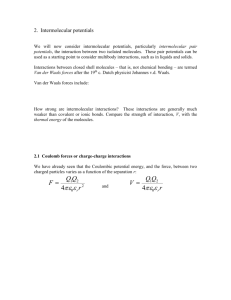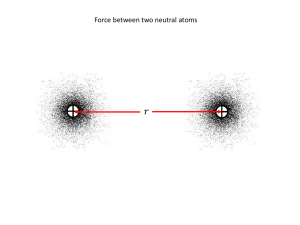File
advertisement

Properties of Various Types of Compounds Answer Key 1. List the three types of intermolecular forces in order of weakest to strongest. Van der Waals: weakest force, present as long as there are electrons moving, non-polar compounds will only have vdw Dipole-Dipole: medium force, between molecules that are polar, slight positive charge on one compound is attracted to the slight negative charge of another compound Hydrogen Bond: strongest force, exist with molecules that contain H bonded to N,O,F 2. Explain why covalently bonded substances are poor conductors of heat and electricity. In order to conduct electricity, there needs to be distinct negative and positive charges to pass the current on, or free flowing electrons. The best covalent compounds can offer are slight negative and slight positive charges that would not successfully pass electricity 3. Why do covalent solids have low melting points? Unlike ionic compounds, which the crystal is a repeating pattern of the compound attracted by complete charges (ionic bond), covalent compounds are held together by forces (not actual bonds) that break easier than bonds, therefore can be separated with little heat. 4. What are van der Waals forces? Weakest intermolecular force (force between molecules), occurs in covalent compounds that have electrons, more electrons in a molecule, the stronger the force 5. What are the strucutral features of substances in which only van der Waals forces are of importance in their inter-particle bonding? electrons 6. In which of the following compounds would hydrogen bonding occur? Explain your answer and remember that lewis structures are a great place to start. a) COCl2 (dipole) b) PH3 (dipole) c) H2CO (dipole) d) CH3OH 7. In which of the following substances would there be the strongest forces between the molecules? a) SiH4 (vdw) b) H2C=O (dipole) c) CH3-CH3 (vdw) d) O2 (vdw) 8. Explain why at room temperature chlorine is a gas, bromine is a liquid, and iodine is a solid. Be sure to first assign each an intermolecular force. All have van der Waals forces. As electron count increase, van der Waals forces increase, strong the force the closer the molecules will be. 9. Explain why water (H2O) is liquid at room temperature by hydrogen sulfide (H2S) is a gas. Be sure to first assign each an intermolecular force. Water has hydrogen bonds whereas hydrogen sulfide has dipole-dipole (a weaker force) 10. What are three key pproperties of solids containing ionic bonds? conductive when aqueous, high melting point, solid at room temperature 11. Describe the bonding that occurs in a metallic solid. Metal ions surrounded by free floating electrons 12. Use the commonly accepted model of metallic bonding to explain why: a. metals are malleable free floating electrons move to where they need to be b. metals conduct electricity in the solid state free floating electrons align with electrical current 13. How do network solids differ from molecular crystals in structure? in hardness? in melting point? Network is one type of element, covalent bound in a lattice, hard and higher melting point than covalent crystals that are held together by forces 14. Classify these substances as ionic, covalent, network, or metallic solids: a. structure composed of atoms covalently bonded to neighboring atoms b. a solid only at extremely low temperatures c. a good conductor of heat and electricity d. a good electric conductor only in solution network covalent metallic ionic 15. Germanium (Ge) is a solid whose atoms are all covalently bonded to each other, much like those of carbon atoms in a diamond crystal. Glycerol [C3H6(OH)3] is an alcohol. Potassium chloride is a white crystalline solid. Methane is a gas which can only be liquefied under high pressures and low temperatures. Rubidium is very malleable and is an excellent conductor of electricity. Which has: a. hydrogen bonding? Glycerol b. the greatest hardness in the solid phase? Ge c. the highest melting point? Ge d. the lowest boiling point? methane e. conductivity of electricity when in solution? KCl f. particles held together primarily by van der Waals forces? methane 16. When ethanol (C2H5OH) boils, the gas consists of a. a mixture of carbon dioxide and water b. carbon, hydrogen, and oxygen c. water and ethanol d. ethanol only 17. Elements A,B, C, and D have consecutive atomic numbers. Element D is a monatomic gas with low melting and boiling points. All efforts to form compounds of D in the laboratory have failed. a. Which of the remaining elements, A, B, or C has the strongest affinity for an additional electron? C b. A compound of an alkali metal M with element C has a formula of MC. Does this compound have ionic or covalent bonds? Predict other properties of MC such as melting point and solubility in water. Ionic, high melting point, highly soluble, conductive c. Write the formulas for hydrides of elements A, B, and C. H3A, H2B, HC d. Predict the shape of each hydride molecule from above. Trigonal pyramidal, Bent 105, linear e. Predict the conductivity of solid B. non-conductive (non-metal) 18. What intermolecular forces are present between the molecules or atoms of the following substances? a. Ne vdw b. O2 vdw c. Br2 vdw d. P4 vdw e. HI dipole 19. For each of the following liquids, list the type of intermolecular forces you would expect to find. water, H2O H-bond bromine, Br2 van der Waals carbon tetrachloride, CCl4 van der Waals 20. Explain the reasons for the difference in boiling points between HF (20 C) and HCl (-85 C) H-bond vs dipole-dipole HCl (-85 C) and (LiCl (1360 C) H-bond vs ionic compound (higher melting point) 21. Match each of the solids in the first column with two properties in the second column. Try to use each property at least once. a. metallic solid (5, 6) I. low melting point b. covalent network solid (2, 5) II. high melting point c. ionic solid (3, 4) III. conducts electricity in solution d. molecular solid (1, 4) IV. brittle V. hard VI. malleable








